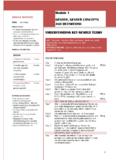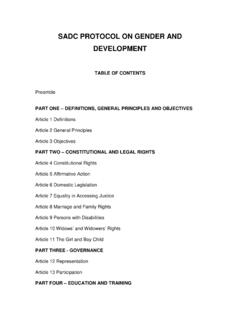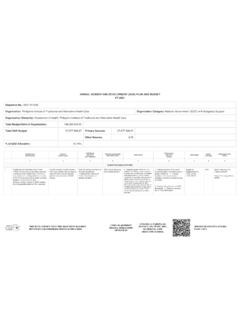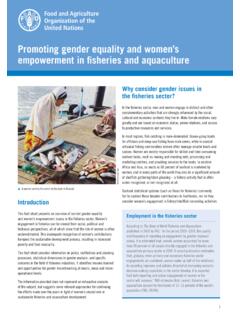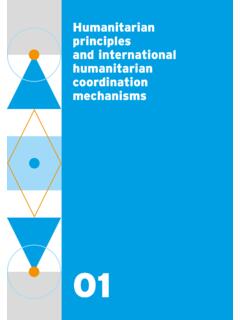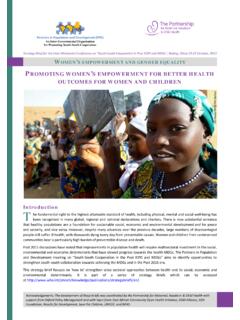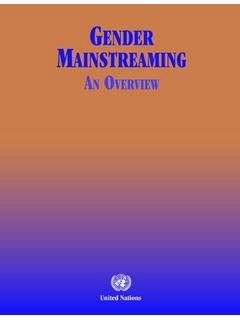Transcription of Introduction to gender analysis concepts and steps
1 Hunt, J, 2004. Introduction to gender analysis concepts and steps , Development Bulletin, no. 64, pp. 100-106. Introduction to gender analysis concepts and steps Juliet Hunt, Independent Consultant Overview During program and project design, gender analysis is the process of assessing the impact that a development activity may have on females and males, and on gender relations (the economic and social relationships between males and females which are constructed and reinforced by social institutions). It can be used to ensure that men and women are not disadvantaged by development activities, to enhance the sustainability and effectiveness of activities, or to identify priority areas for action to promote equality between women and men.
2 During implementation, monitoring and evaluation, gender analysis assists to assess differences in participation, benefits and impacts between males and females, including progress towards gender equality and changes in gender relations. gender analysis can also be used to assess and build capacity and commitment to gender sensitive planning and programming in donor and partner organisations; and to identify gender equality issues and strategies at country, sectoral or thematic programming level.
3 There a number of different frameworks for undertaking gender analysis . Some of these have been developed in Northern countries (Moser 1993; Overholt et al. 1985), and others have been developed and adapted by development practitioners from the South (Parker 1993; Longwe 1991; Kabeer 1994). This article outlines the essential steps that need to be addressed to undertake gender analysis for each of the different levels referred to above, and draws on concepts from a number of different frameworks.
4 Summary of key gender analysis steps 1. Collect sex disaggregated household, workplace and community data/information relevant to the program/project for each area below. 2. Assess how the gender division of labour and patterns of decision-making affects the program/project, and how the program/project affects the gender division of labour and decision making. 3. Assess who has access to and control over resources, assets and benefits, including program/project benefits. 4. Understand women s/girls and men s/boys different needs, priorities and strengths.
5 5. Understand the complexity of gender relations in the context of social relations, and how this constrains or provides opportunities for addressing gender inequality. 6. Assess the barriers and constraints to women and men participating and benefiting equally from the program/project. 7. Develop strategies to address barriers and constraints, include these strategies in program/project design and implementation, and ensure that they are adequately resourced. 8. Assess counterpart/partner capacity for gender sensitive planning, implementation and monitoring, and develop strategies to strengthen capacity.
6 Development Studies Network 139 9. Assess the potential of the program/project to empower women, address strategic gender interests and transform gender relations. 10. Develop gender -sensitive indicators to monitor participation, benefits, the effectiveness of gender equality strategies, and changes in gender relations. 11. Apply the above information and analysis throughout the program/project cycle. Step 1: Collect sex-disaggregated data/information This refers to the differentiation by sex of statistical data and other information and is sometimes called gender -disaggregated data.
7 This means that we must count both males and females when gathering information for planning, implementing, monitoring and evaluating development activities. Disaggregating information by sex is a basic good practice requirement for gender -sensitive programming. Without disaggregated information, it is difficult or impossible to assess the different impacts of development activities on males or females. It is important to disaggregate data not only by sex, but also by age (girls and boys, older men and women), race, ethnicity, caste and any other socioeconomic group which may be affected positively or negatively by a development activity.
8 There are many ways that development workers can gather sex-disaggregated information. Data collection methods and the quantity of data required will vary according to a range of factors, including the sector and type of development activity, the scale of the activity, the resources and time available for data collection during design, implementation and evaluation, and the institutional context. While there are now many sources of quantitative data on the status of women and girls, up-to-date and relevant information specific to the location and activity can sometimes be difficult to get.
9 Sex disaggregated qualitative information based on consultation with key stakeholders and local women s groups is also essential. Participatory methods may provide opportunities to hear from both women and men separately (for example, participatory ways of gathering information on the gender division of labour, or on access to resources), and for women and men to hear each other s perspectives. The following factors may influence the accuracy and coverage of data:1 Who is present: In some cultures women will respond very differently to questions about their economic and social activities, and their views about gender relations if men are present.
10 If men answer questions first, women may remain silent, even if they disagree, or if inaccurate information is given. Time of day, season and location: Women may not be available at certain times of day, and men may be less likely to be present at other times. It is important to choose both a time and place which is convenient for women, for individual and group interviews or participatory information-gathering exercises. Women and men may be less available during peak labour periods, such as harvesting or transplanting times.



